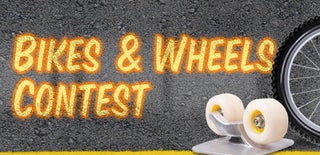Introduction: Electric TurfBoard (FAIL)
The concept of electric skateboards has always piqued my interest; they are the closest thing we have to Marty's McFly's hoverboard. There is no lack of working production models and cool DIY projects:
https://www.instructables.com/id/DIY-Electric-Skateboard/
https://www.instructables.com/id/Propeller-Powered-Skateboard-1/
https://www.instructables.com/id/Easy-build-self-balancing-skateboardrobotsegway-/
I wanted to take a crack at it myself, but the components seemed more expensive than the a fully functional board (≈500$). Once I saw the "Turfboard Deville" being liquidated on Ebay, I knew I had to make it happen. Skip to the last step to see the disappointing results (so far...maybe) otherwise check out what I've attempted to do in the steps. Feel free to comment if you have an elegant solutions to my design issues.
https://www.instructables.com/id/DIY-Electric-Skateboard/
https://www.instructables.com/id/Propeller-Powered-Skateboard-1/
https://www.instructables.com/id/Easy-build-self-balancing-skateboardrobotsegway-/
I wanted to take a crack at it myself, but the components seemed more expensive than the a fully functional board (≈500$). Once I saw the "Turfboard Deville" being liquidated on Ebay, I knew I had to make it happen. Skip to the last step to see the disappointing results (so far...maybe) otherwise check out what I've attempted to do in the steps. Feel free to comment if you have an elegant solutions to my design issues.
Attachments
Step 1: Hardware
The Turf Deville is a trully HUGE BOARD: tall and long enough to tuck all the components neatly under the board. It is also gnarly looking with knobby tires, and red spring. The people that developed this beast must have lost their shirts developing and manufacturing it. The reviews online unanimously panned the board for being too heavy, unmaneuverable and implementing an obsolete snowboard binding system. None of these were cause for concern for my project.
Step 2: Installing Motor and Chain
Both rear wheels had extra cylinders bolted onto the rear wheels that were used for braking (see first picture). I elected to sacrifice one of these to attach the sprocket (stopping has not been my main concern!). I had a holes drilled and threaded at a machinist shop to enable me to attach the sprocket (purchased from a dirt-bike shop).
I simply drilled through the board and bolted the motor in place. The chain was shortened by grinding one of the link bolts off and using a replaceable link. I ended up shortening it by one link; better to shorten than lengthen (always). To add a little tension I jacked up one end of the motor from the board with some spacers. The chain tightness was just right at this point.
I simply drilled through the board and bolted the motor in place. The chain was shortened by grinding one of the link bolts off and using a replaceable link. I ended up shortening it by one link; better to shorten than lengthen (always). To add a little tension I jacked up one end of the motor from the board with some spacers. The chain tightness was just right at this point.
- After the first failed trial (chain skipped off), I significantly tightened the truck bolt to compress the rubber and stiffen the unit.
- I replaced the rubber cushions with steel rings: fail.
- I used stainless steel tie wraps to limit the spreading between the wheels: fail.
Step 3: Steering
This part of the project gave me major head-aches. I desperately wanted the trucks to be sufficient effective to make a turn, this would make the build SO much easier. However, even with both trucks loosened all the way, the turning radius was 100 yards; and I knew that I would have to firm up one set of trucks to attach the motor. I reluctantly decided to go for a scooter type of design.
I wanted to preserve the suspension and wheels, which left me with very few options. I eventually decided to thread a piece of square tubing through a space in trucks and into a set of handle bars from a old kids scooter I picked up (E200). It is frankly a bad solution: it is not smooth and tilts the board in the opposite direction that you would want. I am not sure that I will pick up this project at a later date, but I would likely have to completely rethink the steering. Maybe attach the front end of a scooter and make a single wheel fit in the forks. Frustrating...
I wanted to preserve the suspension and wheels, which left me with very few options. I eventually decided to thread a piece of square tubing through a space in trucks and into a set of handle bars from a old kids scooter I picked up (E200). It is frankly a bad solution: it is not smooth and tilts the board in the opposite direction that you would want. I am not sure that I will pick up this project at a later date, but I would likely have to completely rethink the steering. Maybe attach the front end of a scooter and make a single wheel fit in the forks. Frustrating...
Step 4: Installing the Electronics
This part was rather easy as I had previously wired the whole kit together for the Electric-Snowcat-Pico. You basically follow the instructions that come with the kit. One detail that can cause issues is that you need to join the red and blue wires.
Step 5: Anatomy of a Failed Project
I have probably spent 100 hours on this project and I cannot imagine it working properly due to two MAJOR issues with the current design:
- Chain Skipping: I cant get more than 10 meters before the chain inevitably skips. I have a few potential solutions (killing the shock on this side, screw in the second support on the truck). I am not convinced that this will be sufficient to stabilize the truck.
- The steering mechanism is frankly very weak. It is unreliable and tilt out of the turn. It feels like it is dumping you out of the turn. I may Frankenstein an entire scooter front into the design; I would prefer to keep 4 wheels because the wheel base is already pretty narrow.
Attachments

Participated in the
Bikes and Wheels Contest

Participated in the
Epilog Challenge V

Participated in the
Battery Powered Contest












